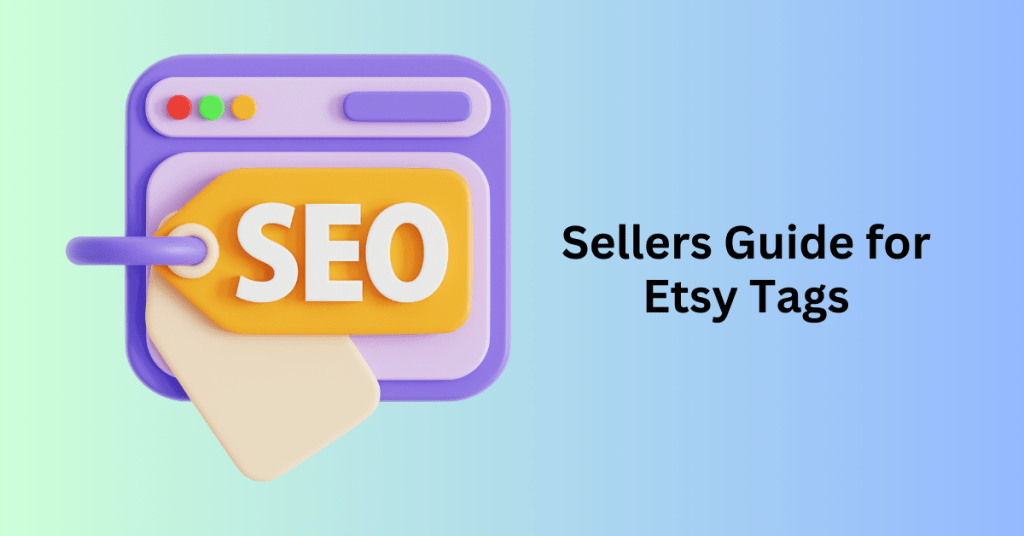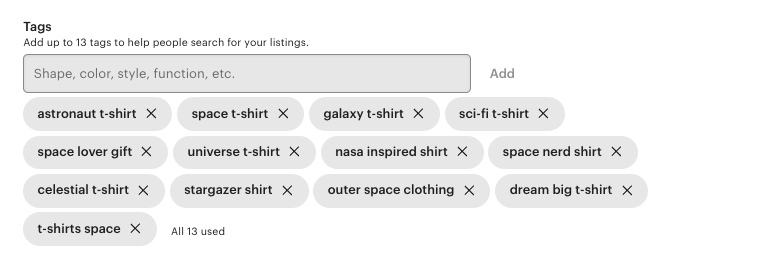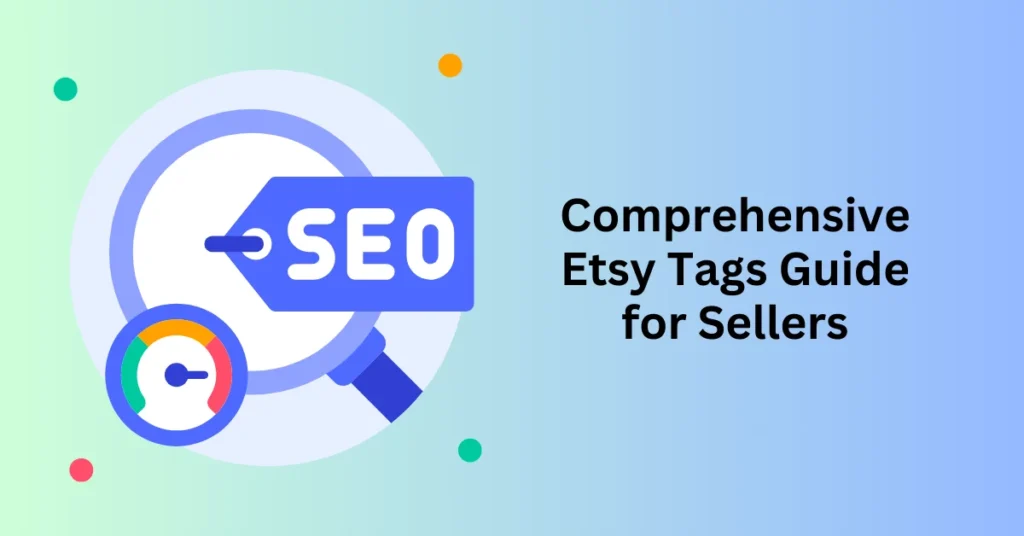Standing out in Etsy’s competitive marketplace requires more than just great products—it demands smart optimization strategies to secure a top spot in search results. In this guide, we’ll walk you through everything you need to know about Etsy tags, including:
- What Etsy tags are and why they’re essential for SEO.
- Step-by-step instructions to update and manage tags effectively.
- Proven methods for researching new keywords to maximize your reach.
- Examples of the best-performing Etsy tags to inspire your listings.
Whether you’re new to Etsy or an experienced seller looking to refine your strategy, this guide will empower you with actionable tips to boost your shop’s visibility and drive more sales. Let’s get started!
Start Your Etsy Store with Print-on-demand Today
Sellers Guide for Etsy Tags
Etsy tags are optional descriptive terms that sellers can add to their product listings to enhance searchability within the platform. These tags act as additional indicators for the Etsy search algorithm, providing context about what the product is and how it might be relevant to a buyer’s query. While categories and attributes—preset options selected during listing creation—define key details like a product’s type, materials, or intended use, tags offer sellers the opportunity to include more nuanced or specific descriptors that don’t fit within the standard options.

Tags can highlight various aspects of a product, such as its style, technique, or even the audience it’s designed for. For instance, if you’re selling a handmade ceramic mug, your tags might include terms like “boho decor,” “minimalist kitchen,” or “coffee lover gift.” Unlike categories and attributes, which are primarily visible to buyers, tags work behind the scenes to inform Etsy’s search engine about your product, helping it appear in relevant search results.
It’s important to note that while tags and primary keywords often overlap, they serve slightly different purposes. Keywords are the terms buyers actively type into the Etsy search bar, while tags refine the search engine’s understanding of your listing. Strategic use of tags, especially those aligned with popular search trends, can improve the visibility and ranking of your product on Etsy, making it easier for potential customers to discover your shop.
Why Are Etsy Tags Essential for Sellers?
Etsy tags play a critical role in improving the visibility of your listings by providing the search engine with extra details about your product. These tags enhance the Etsy algorithm’s understanding of what you’re selling and how it stands out from similar items. By acting as supplementary keywords, tags complement your listing title and description, offering a space to include additional terms that may not fit elsewhere but still align with how potential buyers search for products.
The Etsy algorithm prioritizes matching products to customer search queries using primary keywords. However, tags work alongside these main keywords to refine search results, increasing the likelihood that your product ranks higher and reaches the right audience. Sellers can use up to 13 tags per listing, and utilizing all available tags is a best practice for maximizing Etsy SEO.
For example, if a customer searches for a “cute t-shirt made from sustainable cotton,” Etsy might initially surface several listings with “cute t-shirt” in the title. When the search engine digs deeper, it looks at tags to identify additional relevant matches. Listings with tags like “sustainable cotton” will rank higher for that query compared to items tagged with unrelated materials like “polyester.”
In short, Etsy tags act as a bridge between your product and the search terms customers use, helping you attract buyers by ensuring your listings appear in relevant searches.
How to Add and Update Tags on Your Etsy Listings
Adding and updating tags for your Etsy listings is a straightforward process through the Shop Manager. Here’s a step-by-step guide:
- Access the Listings Section:
Log in to your Etsy account and go to the Shop Manager. Click on the Listings tab to view all your products. - Select the Listing:
Click on the listing you want to edit. This will open the product editor. - Find the Tags Section:
Scroll down or navigate to the Details tab (if applicable, depending on your interface). - Add Tags:
- You can add tags one by one by typing them into the tags field and clicking Add after each tag.
- For faster input, create a list of up to 13 tags in a text editor like Word or Google Docs, separating them with commas. Copy and paste the entire list into the tags field, and the tool will separate them automatically.
- Edit Tags Anytime:
After saving the listing, you can return at any time to edit or update your tags to reflect seasonal trends, updated product details, or changes in your SEO strategy.
Additional Tips
- Updated Listing Tool: Etsy’s listing tool has been updated with enhanced features. If you prefer the old version, you can switch back by clicking the button in the upper-right corner of the screen.
- Avoid Duplicate Keywords: Use tags to include terms that don’t fit into other fields like Category, Attributes, or Materials. This prevents redundancy and maximizes the variety of searchable terms linked to your product.
By using all 13 tags effectively and updating them as needed, you can improve your Etsy SEO and increase the chances of your listings being discovered by potential customers.
Best Practices for Using Etsy Tags
To make the most of Etsy’s tag feature, consider the following tagging strategies to optimize your product listings and improve search visibility:

Tagging DOs
- Use All 13 Tags:
Maximize your opportunities by filling all 13 available tag slots. This increases the variety of search terms associated with your listing. - Utilize the 20-Character Limit:
Make tags as descriptive as possible within the 20-character limit. For example, the tag “recycled polyester” is more efficient than splitting it into “recycled” and “polyester.” - Include Long-Tail Keywords:
Opt for multi-word phrases or long-tail keywords, which are more descriptive and specific (e.g., “personalized baby shower gift” instead of “baby gift”). These target niche audiences and align with detailed search queries. - Incorporate Regional Variations and Synonyms:
Adapt to your audience by including regional terminology. For instance:- UK: “grey trainers”
- US: “gray sneakers”
- Monitor and Adjust Tags:
Use Etsy’s Shop Stats to identify underperforming listings. Update and diversify their tags based on analytics or trending search terms.
Tagging DON’Ts
- Avoid Repetition:
Refrain from duplicating words across tags (e.g., “bear art” and “bear designs”). Diversify by using phrases like “animal art” and “bear designs.” - Don’t Copy Categories or Attributes:
If a product is already categorized as a “Statement Ring,” there’s no need to repeat that in the tags. Use tags for details not covered in categories or attributes. - Avoid Translating Tags:
Stick to the language you’ve set for your shop. Etsy’s algorithm automatically translates tags for international buyers. However, if your shop is multilingual, use Etsy’s dedicated translation fields for more control. - Skip Plurals:
Use singular terms like “mug” instead of “mugs.” Etsy automatically matches plural searches with their singular equivalents, saving you space for additional unique tags. - Eliminate Misspellings:
Avoid using misspelled tags, as Etsy’s search engine corrects typos. Including errors wastes valuable tag space.
By following these best practices, you’ll enhance the effectiveness of your tags, ensure better alignment with customer searches, and improve the overall visibility of your products in Etsy search results.
Start Your Etsy Store with Print-on-demand Today
How to Research Tags for Your Etsy Listings

If you’re struggling to come up with effective tags for your Etsy listings, several tools and strategies can help you identify terms that work well with the Etsy algorithm. Here’s how to get started:
1. Use Etsy Keyword Research Tools
Dedicated Etsy keyword tools can provide valuable insights into popular search terms and related phrases. These tools not only help with primary keywords but also suggest additional terms that are ideal for tags.
- Recommended Tools:
- eRank: Offers detailed keyword analysis and competitive research.
- Alura: Provides keyword suggestions tailored to Etsy searches.
- Sale Samurai: Includes search trends, competition analysis, and long-tail keyword ideas.
2. Leverage Etsy’s Search Auto-Suggestions
Etsy’s own search bar is a goldmine for finding relevant tags.
- How to Use It:
- Type your main keyword or product name into the search bar.
- Note the auto-suggestions that appear as you type. These are based on actual search data and can guide you in selecting high-performing tags and additional keywords.
Example: Typing “ceramic mug” might show suggestions like “ceramic mug gift”, “handmade ceramic mug”, or “ceramic mug set.”
3. Try an Etsy Tag Generator
Tag generator tools are designed specifically to help Etsy sellers find tags related to their product keywords.
- Recommended Generators:
- KeySearch: Generates tags based on your main keyword.
- Tag Wizards: Offers quick and easy tag suggestions for Etsy listings.
- ChatGPT: You can also use AI tools like ChatGPT. Example prompt:
“Generate Etsy tags for the keyword ‘handmade candles.’ Keep each tag within 20 characters.”
Examples of Effective Etsy Tags
Using well-thought-out tags can significantly improve your product’s visibility by helping the Etsy algorithm match your listings with potential buyers’ searches. Below are examples of some of the best types of tags, along with their purposes and practical uses.
1. Descriptive Tags
Descriptive tags provide a valuable opportunity to add more specific details about your product. These details may not fit within Etsy’s pre-set fields. In addition to the basic categories, these tags can enhance your listings. They do so by offering personalized descriptions or multi-word phrases that capture key aspects of the item. Descriptive tags expand on the information already included in your categories. As a result, your listings can stand out and attract more targeted customers. Furthermore, they allow you to highlight unique features, materials, or characteristics of your products. These may not be addressed by standard dropdown options. For example, descriptive tags like “reusable bag,” “rustic wall decor,” or “custom bracelet” help you convey the distinct qualities of your items more effectively.
2. Occasion-Based Tags
Occasion-based tags are effective for targeting shoppers searching for gifts or decorations for a specific event or holiday. By using these tags, you can increase your visibility during peak times of the year. This includes major holidays or wedding seasons. As a result, your products will be more likely to reach customers who are shopping for a particular occasion. Additionally, using occasion-based tags ensures your listings remain timely and relevant. It’s also important to update your tags after seasonal sales. This helps maintain their relevance throughout the year. For example, occasion-based tags like “Halloween gift,” “Christmas stockings,” and “engagement ring” can attract shoppers looking for specific items tied to a special occasion.
3. Audience-Specific Tags
Audience-specific tags are incredibly valuable for reaching shoppers who are looking for personalized or meaningful gifts. Even when the buyer doesn’t have a specific product in mind, these tags can help guide them based on their knowledge of the intended recipient. They allow your listings to connect with customers who know the type of person they’re shopping for but need assistance in choosing the exact item. Using these tags increases the likelihood of your products being discovered by buyers seeking gifts for certain people. Examples include “gifts for teachers,” “presents for girlfriend,” or “football players gift.”
4. Material and Technique Tags
Material and technique tags serve as an extension of the material and technique fields provided by Etsy, offering a chance to provide more detailed or specialized information. This is particularly useful for customized or uniquely crafted items. Tags like these help give buyers additional confidence about the craftsmanship or materials used in a product, showcasing the expertise and quality involved in its creation. Adding such tags can also make your listings more discoverable to customers who value specific materials or crafting methods. Examples include “all-over print clothing,” “custom embroidery,” “natural diamond ring,” and “maple wood sheets.”
5. Style and Size Tags
When shoppers are looking for items that fit a specific aesthetic, style, or size, using the right tags can be the key to making your listings more visible. These tags are especially important for highlighting elements like artistic styles, time periods, color schemes, or dimensions that align with the shopper’s preferences. They help attract customers who are searching for specific types of designs or sizes, ensuring your products meet their needs. By using style and size tags, you increase the chances of being found by customers with particular tastes. Examples include “minimalist home decor,” “vintage kitchen accessories,” “tiny 80s stickers,” “heart-shaped ornaments,” and “art-deco lamp.
6. Use Case and Problem-Solving Tags
These tags showcase how your product can be used or the problem it solves. They are great for practical items that add value to everyday life by improving organization, enhancing productivity, or simplifying tasks.
- Why It Matters: Buyers are often searching for functional items that address specific needs.
- Examples: Makeup organizers, storage box, workout journals, lunch box decal.
By strategically using these types of tags, you’ll ensure your products are better positioned in Etsy search results, attracting a broader and more targeted audience. Regularly update your tags to stay relevant to seasonal trends, buyer behaviour, and new product features.
Other Key Areas to Optimize and Use Relevant Keywords
Optimizing your Etsy shop with the right keywords goes beyond simply using tags. To maximize visibility and increase the likelihood of conversions, focus on refining these additional areas:
1. Categories
Etsy provides a broad selection of predefined categories and subcategories to help classify your products, allowing you to accurately organize your listings. While you can’t create custom categories, it’s essential to select the most fitting one for your product since categories function similarly to tags, improving search visibility. Best practices suggest choosing the category that most closely aligns with your product’s main purpose. If your product could belong to a category not listed, make up for this by adding relevant tags to further describe it. For example, if you sell handmade coasters, opt for the “Home Décor > Coasters” category instead of a broader category like “Accessories.” You can optimize this section in the Listings area under the Details tab.
2. Attributes
Etsy’s attribute fields provide more specific details about your products, such as size, colour, material, or intended use. These attributes are automatically based on the category you select and help refine search results, making it easier for buyers to find exactly what they are looking for. Attributes are important because they free up space for other tags by allowing you to place key product details elsewhere in your listing. To optimize your listings, it’s essential to fill out as many attributes as possible and highlight any unique features, such as “Organic Cotton” or “Hand-Painted.” These fields can also be optimized in the Listings section under the Details tab.
3. Titles
A well-crafted title is a crucial factor for Etsy’s internal search algorithm as well as for external search engines like Google. To write effective titles, it’s important to place the most relevant keywords at the beginning. Avoid stuffing titles with too many keywords or using repetitive phrases. Instead, aim for a combination of descriptive and unique terms that will help your listing stand out. It’s also essential to keep your titles concise, as excessively long titles might get truncated in search results. For example, instead of a generic title like “Men’s T-Shirts, Stylish T-Shirts, T-Shirts for Gifts,” a better option would be “Stylish Men’s T-Shirt – Perfect Gift for Him.” You can optimize this in the Listings section under the About tab.
4. Product Descriptions
Your product description is another critical element for matching keywords to search queries and giving potential buyers a compelling reason to purchase. When writing your description, make sure to incorporate relevant keywords naturally at the beginning, without repeating the exact phrasing from your title. Adopting a conversational tone allows you to elaborate on the product’s features and benefits, providing more context for the buyer. Additional technical details, such as size information or product specifications, can be added toward the end. It’s important to highlight how the product addresses a problem or fulfills a specific need.
For example, instead of repeating the same keywords like “Men’s T-Shirt, Stylish T-Shirt,” you might say, “This stylish men’s T-shirt is crafted from 100% organic cotton, offering comfort and durability for everyday wear. Perfect as a gift for him or a staple in your wardrobe.” This can also be optimized in the Listings section under the About tab.
Final Thoughts: Comprehensive Etsy Tags Guide for Sellers
Optimizing your Etsy shop requires a comprehensive strategy, combining the effective use of tags, titles, descriptions, categories, and attributes. These elements work together to enhance your SEO, improve your listings’ visibility, and ultimately drive sales.
- Maximize Tags: Take full advantage of all 13 tags, ensuring they complement other listing details without duplicating information. Focus on relevant keywords that align closely with shopper searches to boost discoverability.
- Leverage Tools: Use keyword research tools and Etsy’s search suggestions to identify powerful and relevant terms for your tags and listings.
- Monitor and Refine: Continuously track the performance of your listings, and make adjustments to tags and keywords for underperforming items to improve their visibility.
By regularly fine-tuning these elements and staying proactive, you can ensure that your Etsy shop remains competitive, attracts the right audience, and generates consistent revenue.


